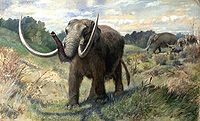Mastodon
 From Conservapedia
From Conservapedia | Mastodon | |
|---|---|

| |
| Scientific classification | |
| Kingdom Information | |
| Kingdom | Animalia |
| Phylum Information | |
| Phylum | Chordata |
| Class Information | |
| Class | Mammalia |
| Order Information | |
| Order | Proboscidea |
| Family Information | |
| Family | Mammutidae |
| Genus Information | |
| Genus | Mammut |
| Species Information | |
| Species | M. americanum M. cosoensis M. furlongi M. matthewi M. pentilicus M. raki M. spenceri |
| Population statistics | |
| Conservation status | Extinct |
Mastodon refers to several extinct species of elephant-like mammals of the family Mammutidae.[1]
Description[edit]
The physique of mastodons resembled that of modern elephants, but was longer and lower. The downward-sloping forehead was characteristic. In contrast to the gomphotheres with its hump-like tooth pattern, mastodons had distinctly zygodontic jaws, that is, the teeth had strong ridges between the paired teeth, arranged transversely to the longitudinal axis of the tooth, on their occlusal surfaces. The milk molars and the first two molars showed trilophodont, while the last molar had four. The tooth morphology suggests that it was a browser, plucking leaves off of trees. Early representatives of the mastodons still had four tusks, one pair each in the upper and lower jaws. Later forms had only upper jaw bones, while the lower ones were reduced by the shortening of the lower jaw, and later were no longer formed.
The name itself is derived from the Greek words μαστός (mastos, "teat" or "breast") and οδον (odon, "tooth") and refers to the particular tooth structure. It was officially introduced in 1817 by the French paleontologist Georges Cuvier, but at that time he used it to describe the distantly-related Gomphotherium angustidens, and is attributed to those mammals of Gomphotherae. Because of this the term "mastodon" is used only rarely in the field of literature, and when used it refers to the American mastodon.
Species[edit]
- Mammut americanum
- Mammut cosoensis
- Mammut furlongi
- Mammut matthewi
- Mammut pentilicus
- Mammut raki
- Mammut spenceri
Evolutionary claims[edit]
The theory of evolution claims that mastodons developed in Africa from the species Palaeomastodon. According to molecular genetic studies, they split from the developmental line to the present-day real elephants 26 million years ago in the upper Oligocene. The theory states the first fossil records began with Eozygodon, from the lower Miocene about 22 million years ago. From this developed Zygolophodon, an animal with four tusks, the upper ones bent downwards, while the much smaller lower ones had a straight course. In the course of evolution, however, the lower canines were reduced, while the molars assumed a more zygodontic shape. In Central Europe, discoveries of the species Zygolophodon turicensis from Elgg (Switzerland) and Esselborn (Germany) are known.
The American mastodon (Mammut americanum) is believed to have lived in North America until about 10,000 years ago and belonged to the last members of a whole group of primitive mammals, reaching a shoulder height of about 8 feet and wearing a coat of thick hair to adapt to the cool-to-cold climate. The two tusks were clearly swung upwards. It has been found in numerous sites in Canada and the USA, but also by some sites in Central America, such as finds from Mexico and Honduras.
Creation science claims[edit]
Creation science states that mastodons were created by an act of God during the Creation Week, between 4000-8000 BC; fossil remains found embedded within sedimentary rock were those animals which died during the Great Flood.
Notes[edit]
- ↑ Nuttall Encyclopedia of General Knowledge, article on Mastodon originally published in 1907 written by Reverend James Wood
Categories: [Mammals] [Extinct Animals] [Prehistoric Mammals] [Proboscidea]
↧ Download as ZWI file | Last modified: 02/08/2023 00:47:29 | 5 views
☰ Source: https://www.conservapedia.com/Mastodon | License: CC BY-SA 3.0
 ZWI signed:
ZWI signed: KSF
KSF